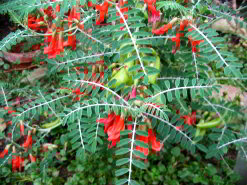
Latest study on ‘miracle’ HIV plant
by Janine Erasmus South Africa’s Department of Science and Technology (DST) has thrown its weight behind the study of a small indigenous legume that, reports say, is effective in treating symptoms of HIV/Aids. The humble Sutherlandia frutescens is a small shrubby plant that’s popular in South African gardens because it’s hardy, attractive, and brings sunbirds to pollinate […]

by Janine Erasmus
South Africa’s Department of Science and Technology (DST) has thrown its weight behind the study of a small indigenous legume that, reports say, is effective in treating symptoms of HIV/Aids.

The humble Sutherlandia frutescens is a small shrubby plant that’s popular in South African gardens because it’s hardy, attractive, and brings sunbirds to pollinate its red flowers – but traditional healers, among them the renowned 82-year-old sangoma Credo Mutwa, have long used it to treat a range of ailments.
The DST has allocated R10-million (US$1.4-million) to a new study investigating the safety and efficacy of the plant, dubbed the cancer bush, to establish the health benefits it holds for those affected by HIV and Aids.
The plant is also known as phetola (“it changes”) in seTswana, and insiswa (“the one that drives away the darkness”) in isiZulu.
Various studies have shown that Sutherlandia helps the body to cope with mental and physical stresses by strengthening its own resources.
According to experts, this ability means that the plant should be classified as an adaptogen – that is, a herb or other substance that increases the body’s ability to resist stress, whether internal or environmental, and that strengthens the immune and nervous systems.
While traditional healers have a healthy respect for S. frutescens, to date there is no definite scientific data to back up their faith in the plant. However, preliminary clinical results look promising.
Traditional uses for the miracle plant include the treatment of depression and anxiety, asthma and bronchitis, kidney infections, moderate hypertension, rheumatoid arthritis and chronic fatigue syndrome.
It has also been used as a general health booster, to wash open wounds, bring down fever and to combat wasting from tuberculosis, HIV/Aids and cancer, as well as to stimulate the appetite in ailing patients. It is said that healthy patients with no underlying wasting conditions show no weight gain.
Supporters claim that the plant slows the progression from HIV to full-blown Aids, although it may not bring on an actual remission. Clinicians in South Africa and Australia have linked it to higher CD4 blood cell counts and a lower viral titre in HIV-positive patients.
Clinical trial
The study, to be overseen by the South African Herbal Science and Medicine Institute (SAHSMI) at the University of the Western Cape, is classified as a phase IIB clinical trial.
The institute has conducted clinical and scientific studies on Sutherlandia since 2004, and holds unpublished phase IIA trial data that shows a high level of tolerance and no side effects in patients that ingested the plant. Researchers hope that the study results will be ready for publication later in 2011.
SAHSMI’s function is to focus on the study of South Africa’s wealth of indigenous medicines and remedies, and to validate their effects by using science to isolate the active ingredients and establish how they work.
The institute is home to the International Centre for Indigenous Phytotherapy Studies, which is particularly interested in indigenous remedies for HIV, Aids and the manipulation of the immune system.
The centre says that of South Africa’s 21 000-plus plant species, about 3 000 are used medicinally by about 80% of citizens, who have no other access to medication. It is therefore vital to reach a greater understanding of these natural substances.
Currently the facility, which has come under fire from pharmaceutical companies and mainstream researchers from time to time, is the only one in South Africa that offers these particular studies.
“The majority of people in South Africa use traditional medicines,” says SAHSMI director Quinton Johnson, “so collaboration to understand this indigenous health system is in the interests of public health.”
Thorough investigation
Clinical trials are conducted in a series of phases, each of which has a specific purpose and yields different information.
Phase I trials take place on very small groups of people – usually a maximum of 80 – and if successful, the product passes into the second phase, which sees it tested on bigger groups of up to 300 subjects.
The third phase involves groups of up to 3 000 and in addition to safety and efficacy, other factors monitored include side effects and comparative data with existing treatments. The final phase involves the gathering of information after the product reaches the market.
A phase IIA study will typically monitor the drug’s effectiveness, while a phase IIB study is conducted to gather information on dosing requirements. Some studies conduct both phases at the same time.
A report on the clinical trials website of the US National Institutes of Health describes the history of the completed phase I safety trial for Sutherlandia. The study was conducted with adult volunteers, also with the participation of the University of the Western Cape. Data is available from the start of the study in July 2004 to its completion in March 2007.
According to the report, the study was conducted on 24 healthy individuals between the ages of 18 and 45, to assess the safety of S. frutescens on the kidney, liver, cardiac, intestinal, muscle, metabolic and bone marrow function of the volunteers.
Haylene Nell of the Tiervlei Trial Centre was the principal investigator and co-author of an article on the trial, that was published in 2007 on the research portal PLoS Clinical Trials.
South Africa’s Medical Research Council also released a final report in 2002 on a safety and efficacy study of S. frutescens subsp microphylla, which involved vervet monkeys. None of the creatures suffered any ill effects, even those in a group that was fed nine times the recommended monkey-sized dose. The study is available for download (PDF, 273KB).